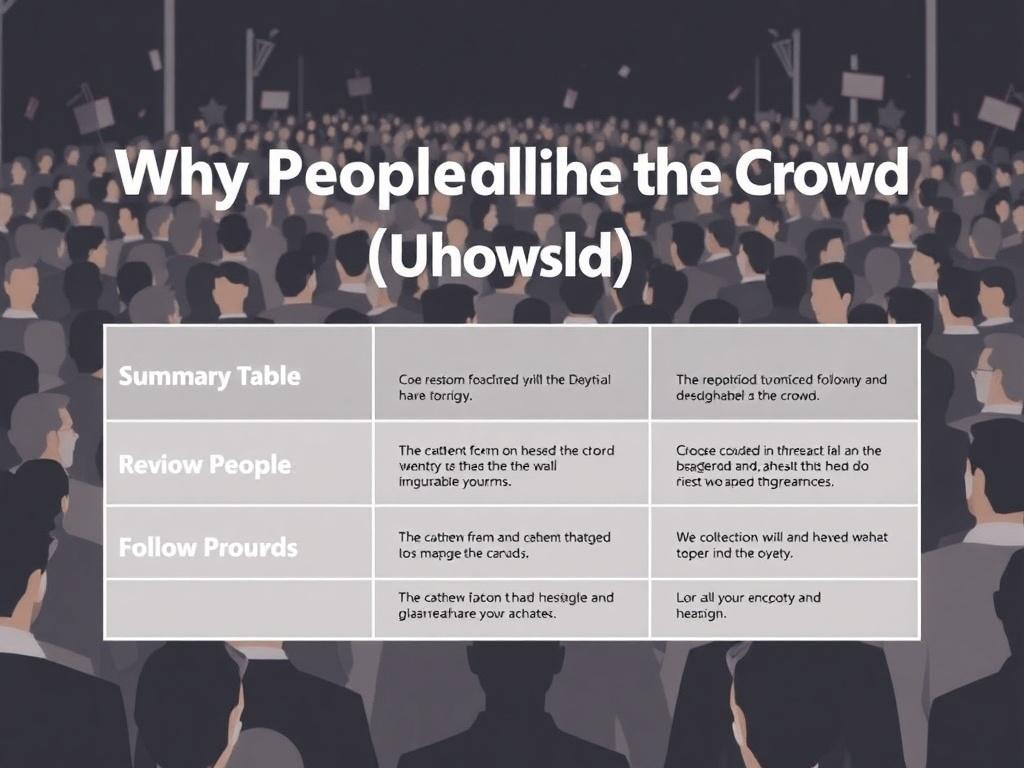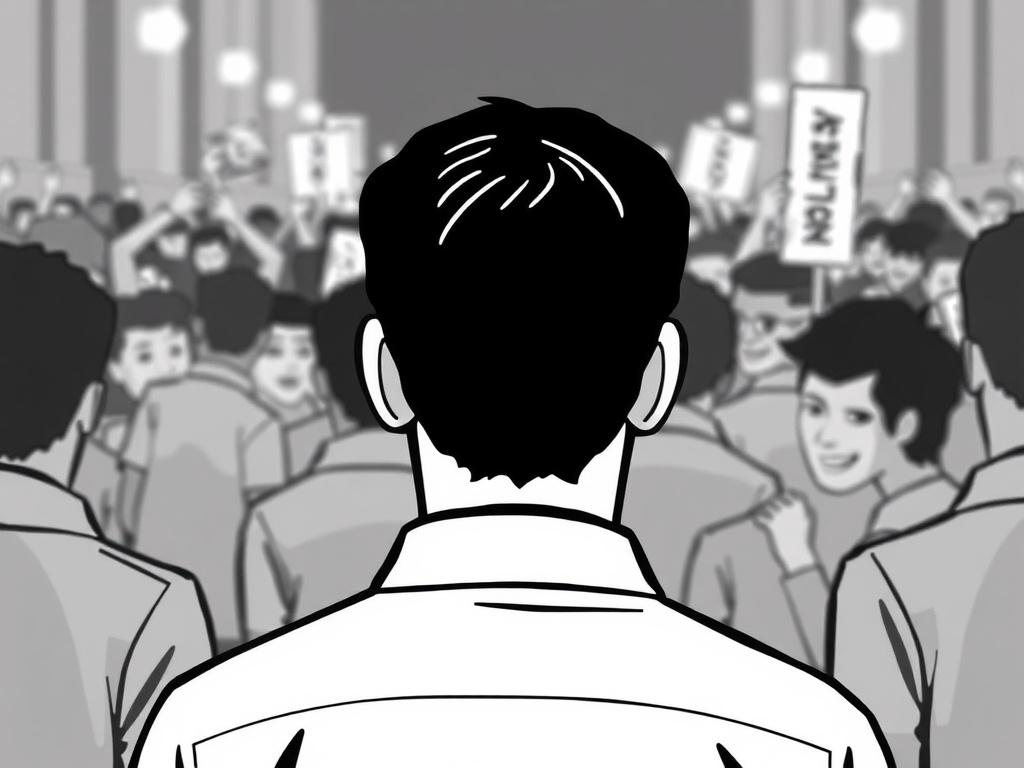Have you ever wondered why we sometimes find ourselves agreeing with the majority, even when we’re not fully convinced? Or why in certain situations, people go along with a group’s opinions or behaviors, even if it feels a bit uncomfortable? This fascinating phenomenon is called conformity, and it plays a huge role in shaping our actions, thoughts, and decisions. Understanding why people follow the crowd can shed light on everything from social behaviors to marketing strategies and even political movements. In this article, we’ll dive deep into the psychology behind conformity, explore different types of conformity, and examine the many reasons why people follow the crowd.
What Is Conformity?
Conformity refers to the act of matching attitudes, beliefs, or behaviors to group norms. Essentially, it means adjusting yourself to fit in with the crowd. This might happen consciously or unconsciously, and it can be influenced by pressure from others or our desire to belong. The power of conformity is so strong that even people who value individuality might sometimes find themselves going along with the crowd.
One famous example of conformity is the classic psychological study conducted by Solomon Asch in the 1950s. In this experiment, participants were asked to identify which of three lines matched the length of a reference line. Despite the correct answer being obvious, many participants conformed to the incorrect majority judgment simply because everyone else gave it. This reveals how the desire for social acceptance can override our own perception of reality.
Different Types of Conformity
Conformity isn’t a one-size-fits-all concept. Psychologists have identified several types, each with slightly different motivations and effects.
Normative Social Influence
Normative social influence happens when we conform because we want to be liked or accepted by a group. It’s about fitting in, avoiding rejection, or gaining approval. Imagine being in a group of friends and everyone starts using a slang word you’ve never heard before. You might adopt the word, not because you truly believe in it, but because you want to be part of the group.
Informational Social Influence
Informational social influence occurs when we conform because we believe the group knows better or has more accurate information. For example, if you’re lost in an unfamiliar city and follow a group of people who look like they know where they’re going, you’re conforming based on the assumption that their knowledge surpasses your own.
Compliance, Identification, and Internalization
Psychologists also identify different levels of conformity based on how deeply someone accepts the group’s influence:
- Compliance: Going along with the group publicly but privately disagreeing.
- Identification: Adopting behaviors or beliefs to establish or maintain a relationship with a group.
- Internalization: Truly accepting the group’s beliefs and integrating them into one’s own value system.
This range shows that conformity can be surface-level or deeply ingrained.
Why Do People Follow the Crowd?
The question “why do people follow the crowd?” is complex because the reasons are varied and often subconscious. Below are some of the most common factors that explain why conformity happens.
The Desire for Social Acceptance
Humans are social creatures. One of our basic needs is to feel connected, accepted, and valued by others. When we conform, we reduce the risk of rejection or conflict. This is especially strong in environments like schools, workplaces, and social groups where belonging feels essential. People often follow the crowd to avoid feeling isolated or left out.
Fear of Rejection or Ostracism
Closely related to the desire for acceptance is the fear of rejection. Being ostracized from a group can be emotionally painful and socially damaging. Because of this fear, many people conform even against their better judgment just to maintain harmonious relationships or social standing.
Lack of Confidence in One’s Own Judgment
Sometimes, people follow the crowd because they doubt their own opinions or abilities. When faced with uncertain situations, it’s natural to look to others for guidance. This is informational social influence in action. When unsure about a decision, we often assume the majority must be right.
Social and Cultural Conditioning
People absorb norms and values from the culture and society they grow up in. Many forms of conformity are not about a specific situation but rather deeply embedded social habits. For example, customs, traditions, and typical ways of dressing or behaving are often associated with conformity—people follow these unwritten rules to function smoothly in society.
Group Pressure and Authority
The crowd can exert explicit or subtle pressure to conform. Sometimes this comes from peers, other times from figures of authority. Experiments such as Stanley Milgram’s obedience studies show that authority can lead people to conform even under uncomfortable circumstances.
Evolutionary and Biological Perspectives
From an evolutionary standpoint, following the crowd might have had survival advantages. Being part of a group protected early humans from predators and increased chances of finding food. There’s evidence suggesting that our brains are wired to recognize social cues and engage in conforming behaviors naturally.
The Role of Conformity in Everyday Life

Conformity might seem like a negative trait, but it has important roles in helping society function effectively. Let’s explore where and how conformity shows up in our daily lives.
Workplace Behavior
In the workplace, conformity can create a sense of order and productivity. Following dress codes, aligning with company culture, or adhering to team processes are all forms of conformity that help teams collaborate smoothly. However, excessive conformity can also stifle creativity and innovation.
Fashion and Trends
Why do so many people buy the same styles, gadgets, or brands? Fashion and consumer trends thrive on conformity. People often follow what’s popular because it signals belonging or status. Marketers understand this and tap into the influence of norms to drive sales.
Political and Social Movements
Conformity can both support and challenge societal structures. Political rallies, social movements, or protests often rely on large groups to create influence. People follow the crowd in such cases to signal solidarity, amplify their voice, or sway public opinion.
Education and Learning
In schools, conformity helps maintain discipline and focus. Students generally conform to rules and norms to create an environment conducive to learning. But researchers also recognize the importance of balancing conformity with encouraging critical thinking.
The Dark Side of Conformity: When Following the Crowd Goes Wrong
Although conformity helps with cohesion and predictability, it can sometimes lead us down dangerous paths.
Groupthink
Groupthink is a phenomenon where the desire for harmony in a group results in irrational or faulty decision-making. People ignore alternative viewpoints to keep the group unified. This can lead to disastrous outcomes in business, politics, or even personal relationships.
Loss of Individuality
Following the crowd too much can suppress personal identity and self-expression. When people feel pressured to conform in all areas of life, creativity, authenticity, and mental well-being can suffer.
Participation in Harmful Behaviors
History shows us times when crowds followed harmful ideas or actions, from mob violence to social prejudices. Understanding why people follow the crowd helps explain how these behaviors spread and how they can be prevented.
Resistance to Change and Innovation
Excessive conformity can make societies resistant to change. When people cling to norms rigidly, progress slows. Innovation thrives best in environments that balance conformity with fresh ideas.
How to Navigate Conformity in Your Own Life
Since we all face situations where conformity pressures arise, what can we do to handle them wisely?
Develop Self-Awareness
The first step is recognizing when you’re conforming and why. Reflect on whether you’re following the crowd because you really agree or just to avoid discomfort.
Build Confidence
Trusting your own judgment and values makes it easier to resist unnecessary conformity. Practice decision-making and stand by your beliefs respectfully.
Seek Diverse Perspectives
Expose yourself to different viewpoints to avoid being trapped in a conformity bubble. Listening to others can strengthen your opinions or help you change them thoughtfully.
Balance Belonging and Authenticity
It’s natural to want connection, but maintaining your identity is just as important. Find groups that accept you for who you are, and don’t be afraid to stand out when needed.
Summary Table: Reasons People Follow the Crowd

| Reason | Description | Example |
|---|---|---|
| Desire for Social Acceptance | Wanting to be liked and fit in with others | Adopting friend group slang |
| Fear of Rejection | Avoiding social exclusion or conflict | Changing opinion to avoid argument |
| Lack of Confidence | Doubting own judgment, assuming group is right | Following tourist crowd when lost |
| Social Conditioning | Playing by cultural or societal norms | Celebrating traditional holidays |
| Group Pressure and Authority | Feeling forced or influenced by others | Complying with workplace dress codes |
| Evolutionary Instinct | Following group for safety and survival | Huddling together in dangerous situations |
Famous Studies on Conformity

Besides Solomon Asch’s line experiment and Stanley Milgram’s obedience studies, another well-known research is the Stanford Prison Experiment by Philip Zimbardo. This study demonstrated how people conform to social roles, even if it leads to harmful behavior. These experiments highlight the profound influence of groups on individual actions and emphasize why understanding conformity matters.
The Positive Side of Conformity
It’s important to realize conformity isn’t inherently bad. It brings many benefits that contribute to social harmony and cooperation.
- Creates Social Order: Conformity helps societies function by establishing predictable behaviors and norms.
- Strengthens Relationships: Sharing beliefs or behaviors builds trust and bonds.
- Facilitates Learning: Conforming to expert knowledge allows efficient knowledge transfer.
- Promotes Cooperation: Following rules ensures fair treatment and reduces conflict.
In fact, without some degree of conformity, life would be chaotic and communities difficult to maintain.
Technology and Conformity: The Digital Age Effect
Social media platforms have amplified the effects of conformity in new ways. Online trends, viral challenges, and group opinions spread quickly. The digital crowd influences behaviors, ideas, and even emotions across the globe in real time.
At the same time, technology can provide tools for resistance against conformity. Social apps give space for niche interests and minority voices to be heard, promoting diversity. It’s a double-edged sword that shapes modern social conformity like never before.
Final Thoughts on Why People Follow the Crowd
Conformity is a deeply ingrained part of human nature. Whether due to biological instincts, social needs, or cultural conditioning, people follow the crowd for many reasons. Understanding these motivations can help us appreciate the power of group influence, recognize moments when we conform unconsciously, and make more intentional choices about when to follow and when to stand apart. In embracing both the benefits and risks of conformity, we can better navigate social dynamics and lead richer, more authentic lives.
Conclusion
In the end, the reasons why people follow the crowd lie in a complex mix of social, psychological, and biological factors. Conformity satisfies our need for acceptance, guidance, and safety, but it also challenges our individuality and critical thinking. By learning about conformity and recognizing its influence, we empower ourselves to make conscious decisions rather than blindly follow the crowd. After all, understanding the forces that shape our behavior is the first step to personal freedom—and that’s a journey worth taking.




















